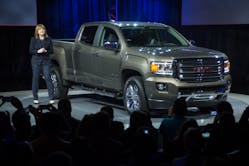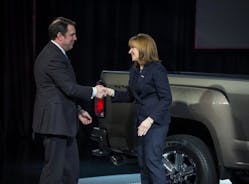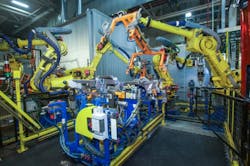That person, of course, would be Mary Barra (seen at right) – GM’s CEO-elect and if I am not mistaken she’s the very first woman to hold a CEO position at any major vehicle manufacturer.
Even more interesting from the perspective of a trade journalist like myself is that Barra chose a truck as the very first vehicle she officially introduced as CEO – not a high-priced luxury car, not the new-and-improved Corvette, not a family-friendly crossover or sport utility vehicle (SUV).
And though the 2015 GMC Canyon is a midsized pickup, it’s still a truck and one that GM is aiming squarely at the commercial side of the light vehicle, along with the Chevrolet Colorado.
That’s something another trend setter in the truck business, Joyce Mattman, emphasized to me last year when GM previewed the 2015 Chevrolet Colorado for journalists ahead of its LA. Auto Show unveiling.
Mattman – commercial product director for GM’s Fleet & Commercial division – told me that a “work truck package” will be provided for the 2015 Colorado, including a “box delete” option so the pickup bed can be removed to provide for the installation of a wide assortment of service body styles.
“The work truck package will include the option for steel wheels, a rear seat delete, rubber floor mats, and a vinyl seat package,” she said.
Mattman added that the growing traffic congestion in cities coupled with “real interest” in fuel economy is expected to drive demand for the “work version” of models like the mid-size Colorado.
“Work fleets have really nowhere to go below a half-ton pickup today, yet the trend towards downsizing and ‘lightweighting’ is gaining speed,” she explained. “In the past, the mid-size pickup didn’t have all the capability a work fleet needed. That’s why we’re bringing that expanded capability back to this segment.”Barra (at left with GM President North America Mark Reuss) sounded a similar theme this week at the 2015 GMC Canyon reveal in Detroit as well.
“Here in North America, the new GMC Canyon is part of our three-truck strategy designed with the customer in mind, making us the only manufacturer that lets buyers choose precisely the right truck for their needs: Light Duty, Heavy Duty or Midsize,” she said.
“The midsize truck segment is especially interesting [as] other manufacturers have either ignored it or abandoned it,” Barra added. “That means midsize pickup customers have had to compromise. To get the features, content and amenities they're looking for, they've had to either leave the segment – most often to a compact crossover or car – or choose from a limited selection. To us, that's no way to treat a customer. That's opportunity knocking.”
That's why she said GM is getting back into the segment with not one, but two all-new midsize pickups based on nameplates it retired two years ago – those nameplates being the Chevrolet Colorado and GMC Canyon.
“We're confident that with these two trucks we can both win conquest sales and grow the segment, simply by listening to customers,” Barra emphasized.
It should also be noted that Barra brings a very broad resume of skills to the CEO position at GM, starting her career at the OEM upon graduating from the General Motors Institute (also known as Kettering University) in 1980 with a Bachelor of Science degree in electrical engineering as co-op student at the now-defunct Pontiac Motor Division.
Along with varied engineering and staff positions, Barra spent the past decades serving as: VP-global manufacturing engineering; as plant manager for Detroit Hamtramck Assembly facility; executive director of competitive operations engineering; VP-global human resources; senior VP-global product development; and executive VP-global product development & global purchasing and supply chain before being designed CEO-elect.
Yet even as Barra notches a place in the light vehicle history books on the personnel side of the ledger, new vehicle engineering advances are making some history of their own at the same time.
For starters, the all-aluminum hood of the 2015 GMC Canyon, not to mention the wide use of aluminum alloys throughout the new 2015 model F-150 pickup introduced by GM rival Ford Motor Co., signals the start of a shift away from the traditional steel backbone that’s long underpinned work vehicles in this segment.Then there are the new manufacturing processes need to work with aluminum on such a scale, with GM recently filing a patent for the aluminum welding process used on its 2014 Corvette Stingray.
GM is also using what it calls a lightweight “shape memory” alloy wire instead of a heavier motorized actuator to open and close the Corvette Stingray’s hatch vent.
Indeed, according to the U.S. Patent Board, GM received 1,672 U.S. patents in 2013 alone that the OEM is now applying to its global product engineering, powertrain engineering, manufacturing, research and development and OnStar organizations.
“Breakthrough technologies like aluminum welding and shape memory alloys show how GM is leveraging its intellectual property for real-world applications,” noted Jon Lauckner, GM chief technology officer, vice president of Global R&D and president of GM Ventures. “Aluminum welding enables increased use of aluminum to shave pounds, which helps to improve fuel economy and driving performance.”
He added that the Corvette Stingray uses 354 spot-welds that eliminate nearly two pounds of rivets from body parts. The process’s multi-ring domed electrode head conducts an electrical current to create intense heat that disrupts the oxide on sheet, extruded and cast aluminum surfaces, enabling a stronger weld.
Then that GM-patented lightweight shape memory alloy wire comes into play by replacing a heavier motorized actuator to open and close the hatch vent that releases air from the trunk. This allows the trunk lid to close more easily than on the previous models where trapped air could make the lid harder to close, while again taking out weight.
Just goes to show that lots of history-making moments are occurring in rapid succession within the light vehicle industry right now. That’s resulting in some pretty significant advances in vehicle capability and efficiency – especially where light trucks are concerned.






